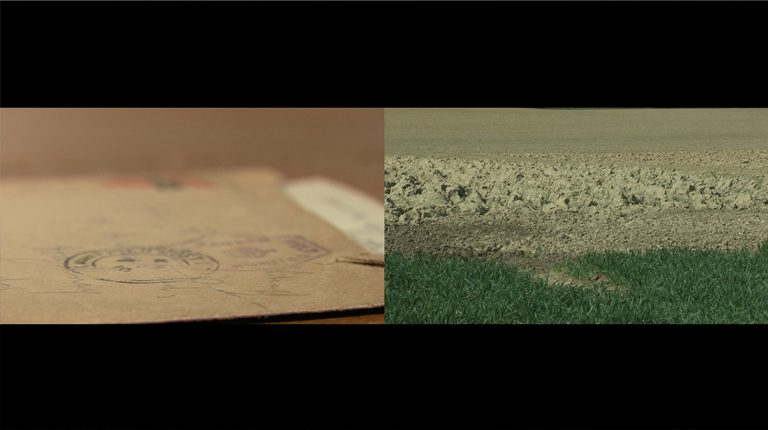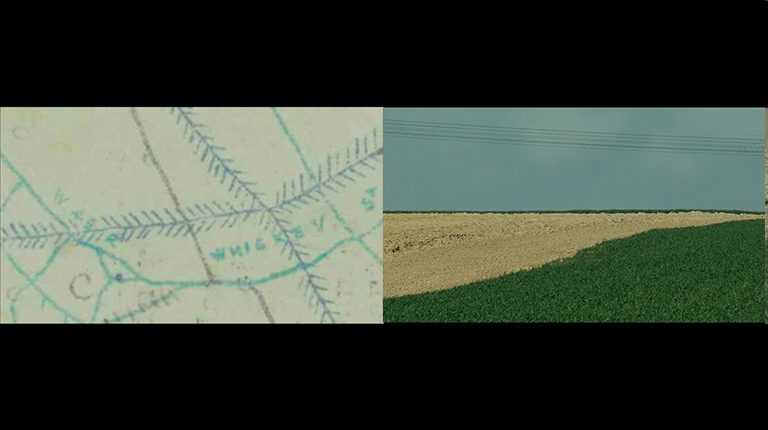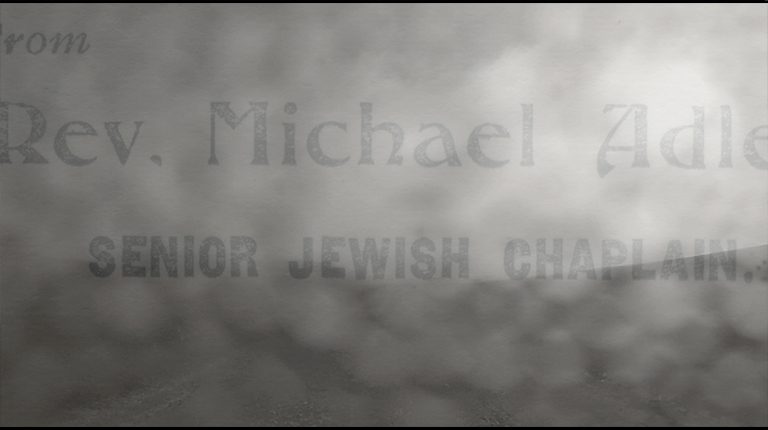My latest series of multiscreen digital films, known collectively as Palimpsest, was commissioned by British artist Sarah Kogan for Changing the Landscape, a multimedia visual arts project supported by public funding from The National Lottery through Arts Council England, currently exhibiting in the reading rooms at The National Archives to commemorate the centenary year of The Battle of the Somme.
The films document a journey from Hackney in east London to the battlefields of northern France, tracing the footsteps of Kogan’s great uncle, mapmaker Rifleman Barney Griew, of 56th Division, London Rifle Brigade, in an endeavor to represent past events alongside contemporary evidence.
In preparation for making the film I spent a number of weeks studying Barney’s letters, the content offering a powerful insight into the life of a young First World War private. His thoughts, stories, and testimonies form a cohesive narrative providing a vision of an extraordinary personal odyssey, which began in England and ended in a muddy field in Gommecourt, where Barney Griew was killed on the first day of the Battle of the Somme (1 July 1916). As well as the rich content, I was drawn to the physical qualities of the correspondence and began filming the letters using a macro lens to get in close to the folds of the paper, the turned up corners and the textures of the pencil line, enhancing the visual elements. The letters became objects in themselves, and when in close up, landscapes in their own right.

Figure 1: Gommecourt Field, Research Photograph
During our research, Sarah Kogan and I travelled to northern France on two occasions to visit the locations where Barney Griew was posted. I found the landscape of the battlefield surprisingly banal and uneventful, and it was difficult to reconcile the gently undulating geography with the dramatic events of 1916. Barney Griew’s journey is indexed by insignificant settings and places, but the banality assumes significance given the historical context, creating a double premise of objectivity and meaning and an invitation to reach into the past and contemplate the events he experienced. Like the surface of the letters, the landscape becomes a mediator to Barney and his final journey.

Figure 2: Palimpsest Still, ‘Letter and Mud’
I filmed these places creating a collection of images to be edited together with the footage of his letters. Using a split screen configuration with a combination of several screens, the images are read across various sources at once. This idea is enhanced by the use of vitrines to exhibit the films, a feature of the Changing the Landscape exhibition in which Sarah Kogan’s artwork is displayed. The final collection of films are shown on four screens simultaneously, encouraging contemplation of a set of ideas through moving images; contingent on an intellectual, physical and emotional response. Within the context of the exhibition, the viewer is required to engage with connections across different media, and varying forms of mediation as they walk through the installation to view the contents of the display cases. Palimpsest is a response to the archive, its title refers to a process of overwriting which is usually associated with parchments, or ancient inscription, where evidence of historical text remains.

Figure 3: Palimpsest Still, ‘Trench Maps and Landscape’
During the making of the films I was fortunate to have access to the extensive research material sourced by Sarah Kogan, who developed Changing the Landscape with the help of William Spencer, principal military specialist at The National Archives. William provided catalogue numbers for the First World War unit war diaries (WO 95), identifying a series of trench maps produced in Gommecourt in 1916. In my film, I use these as an objective view of the walkways and tunnels Barney once occupied. As a mapmaker he would have been familiar with this network and, while there is no signed evidence of his actual work, these were the sorts of maps Barney was tasked with producing for military intelligence. Using a macro lens, I filmed the documents, which included trenches such as ‘Yankee Street’, ‘Whiskey Street’ and ‘Yiddish Street’. With the help of a sound track of flies and insects the sequence suggests close proximity to the landscape – the viewpoint of someone crawling through mud. As we get nearer to the Front the sound track intensifies, creating a more dramatic atmosphere. Bad weather sets in and eventually a crescendo of music, thunder, mixed with distant shelling marks the terrible and dramatic end of Barney’s journey.

Figure 4: Palimpsest Still, ‘Letter from Senior Jewish Chaplin and Landscape’
The film leaves us with the written words of a letter from the Jewish Chaplain, announcing Barney Griew as ‘missing’ to his family and friends. Finally a single portrait of the young 21-year-old Barney appears on the screen, looking out at us over silence.
‘Palimpest’ (2016)
Director: Jeremy Bubb
Camera: Matthew Gunton and Jeremy Bubb
Music: Robert Percy
Digital Consultant: Ian Shand
Thanks to Sarah Kogan
Changing the Landscape is on display in the reading rooms until 17 September with a free discussion, First World War Research Journeys on Tuesday 6 September.
Thank You. . . .
[…] my favourite uses of archives is as an inspiration for the visual art, like this incredible work on archives and landscape by Jeremy Bubb. Who knows what these personal histories concealed inside marbled book covers could inspire. I find […]